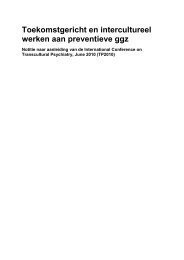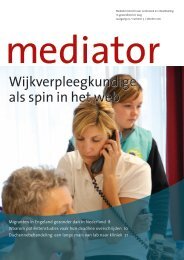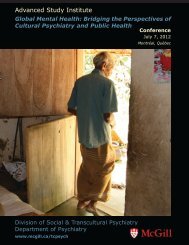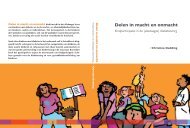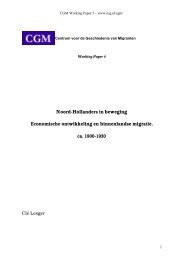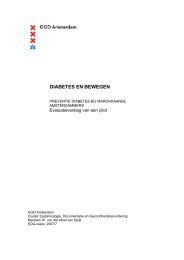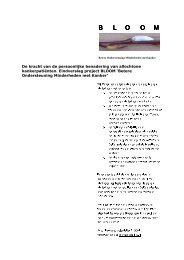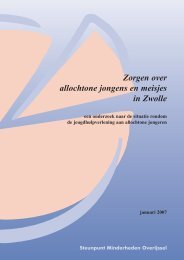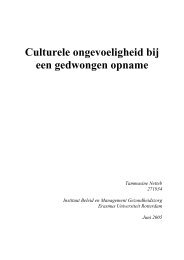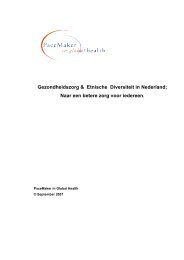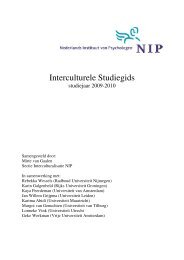Download
Download
Download
Create successful ePaper yourself
Turn your PDF publications into a flip-book with our unique Google optimized e-Paper software.
(11) showed that patients with an extended LOS of at least 25% suffered more often<br />
from an adverse event during hospital admission (odds ratio 3.1; 95% confidence<br />
interval 2.4 – 4.1). In addition, an unplanned readmission after hospitalisation was<br />
associated with a higher risk of adverse events (OR 2.4; 95% confidence interval 1.9-<br />
3.2). Therefore, we chose to study differences in readmission rates and extended LOS to<br />
get an indication of potential differences in patient safety across ethnic groups.<br />
The aim of this study was to assess ethnic disparities in readmission rates and extended<br />
LOS in hospitalisations over a 10-year period in Dutch hospitals. The linkage of data from<br />
three national databases with information on hospitalisation, ethnicity and socioeconomic<br />
indicators offered an unique opportunity to explore ethnic disparities in<br />
outcomes of hospitalisations.<br />
Our second aim was to identify ethnic patient groups at high risk of readmissions and<br />
excess LOS and to assess the effect of age on these risks. We minimized the contribution<br />
of disease related causes to these outcomes by adjusting for these factors in a<br />
multivariable multilevel model.<br />
Methods<br />
Population<br />
We constructed a cohort of patients hospitalised in all Dutch hospitals between January 1,<br />
1995 and December 31, 2005 by linking information from the national hospital discharge<br />
register (HDR), the Dutch population register (PR) and socioeconomic data of Statistics<br />
Netherlands.<br />
Data on hospital admissions were derived from the HDR. Since 1986, all general and<br />
academic hospitals and most single specialty hospitals participate in the hospital<br />
discharge register. For each hospital admission a new record is created in the HDR,<br />
including information on date of<br />
birth, sex, numeric part of postal code (since 1991), hospital-specific patient<br />
identification code, type of hospital, admission date and principal diagnosis of the<br />
admission. The principal diagnosis is determined at discharge and is coded using the<br />
ninth revision of the International Classification of Diseases (ICD-9-CM) (23).<br />
The PR is a dynamic register and comprises information on all registered persons living in<br />
the Netherlands, and contains information on date of birth, sex, current address, postal<br />
code, nationality, country of origin (both of the registered person and his/her parents)<br />
and the date of emigration. The registry is longitudinal and all changes since 1995 are<br />
traceable with their period of validity. It is known that for the entire Dutch population<br />
approximately 85% of the combinations of date of birth, gender and postal code is<br />
unique (i.e., occurs only once in the registry, and thus identifies one person) (24).<br />
The HDR is a database on admissions, not persons. Following individuals over time based<br />
on HDR-information alone is troublesome due to difficulties in identification of different<br />
admissions from the same person in time and admission for the same condition at a<br />
different hospital. Yet, linkage with the PR may solve the majority of these problems. It<br />
has been shown recently that 99% of the personal, admission, and discharge data, and<br />
84% of the principal diagnoses (validated through medical record review by medical<br />
specialists) were correctly registered in a random sample of all hospital admissions<br />
registered in the hospital discharge register (25). In addition, over 97% of the uniquely<br />
linked hospital admissions resulting from linkage of the hospital discharge register with<br />
the population register were shown to be correctly linked (26).<br />
Information on socioeconomic status has been derived from the Social and Cultural<br />
Planning Office of the Netherlands (27). For the years 1994, 1998, 2002, 2006 the social<br />
status of all neighbourhoods in the Netherlands was computed based on education,<br />
unemployment and income. In addition to the definition of social status of<br />
36



